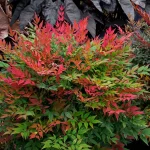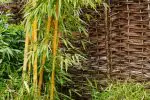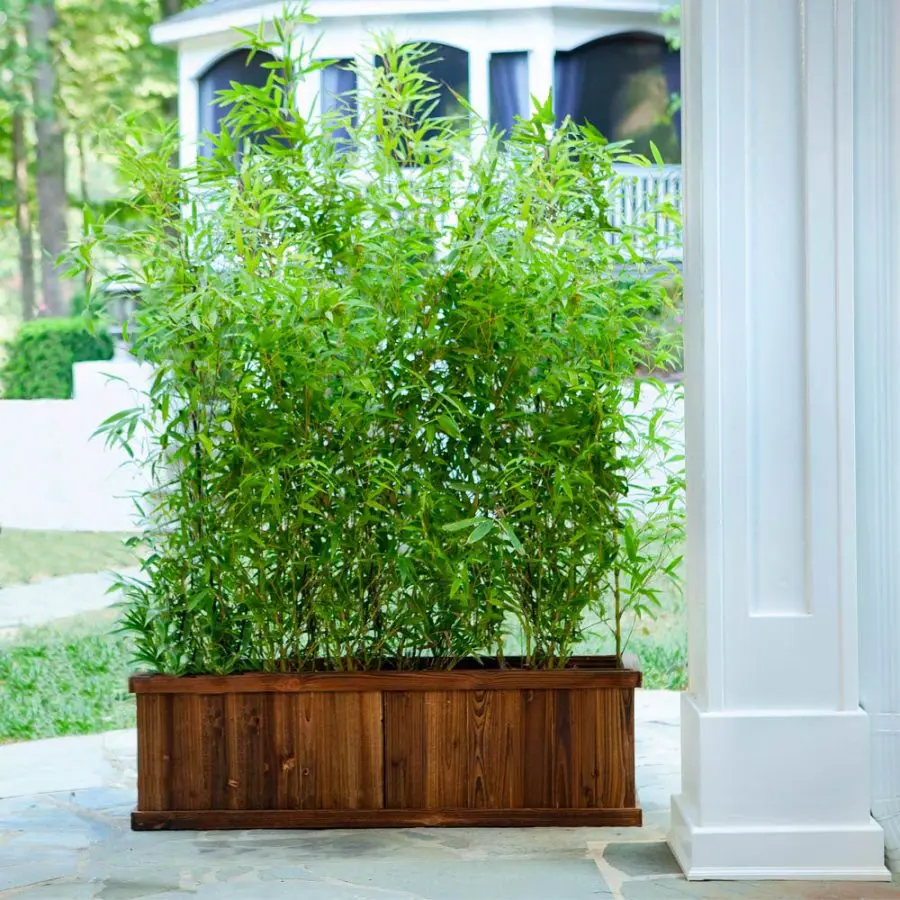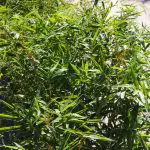This post contains affiliate links. If you buy something from one of our links we may earn a commission. Thanks
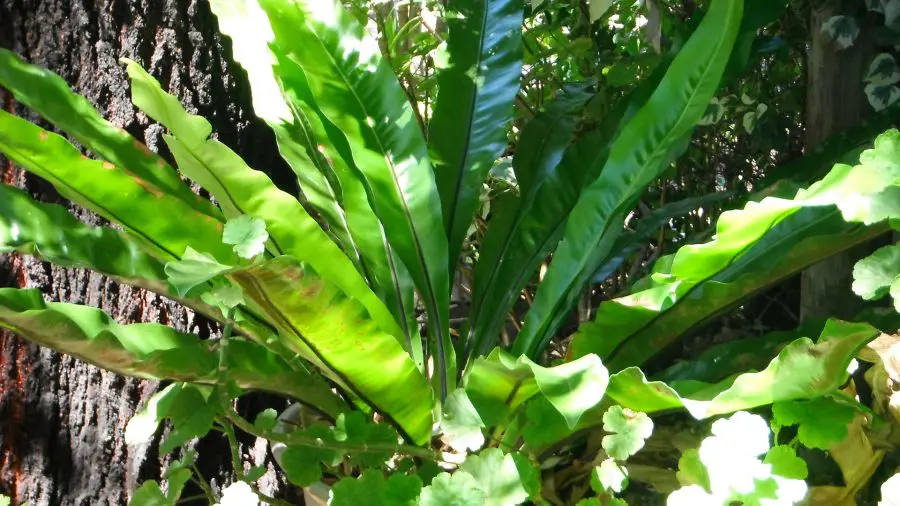
Discover how to create a lush indoor garden by learning the tips and tricks for Caring for Bird’s Nest Ferns Indoors.
Caring For Bird’s Nest Fern Indoors
Key Takeaways
- To grow Bird’s Nest Fern or Asplenium nidus indoors, place the plant in indirect sunlight and keep the soil consistently moist.
- Ensure good drainage and maintain a humid environment. Fertilize lightly during the growing season.
- This fern is well-suited for indoor conditions, making it a popular choice for houseplant enthusiasts.
Caring For Bird’s Nest Fern Indoors
Are you looking for a simple yet stunning addition to your indoor plant collection? It’s easier than you think!
Look no further than the Bird’s Nest Fern!
Caring for Bird’s Nest Fern indoors is a breeze with these helpful tips and tricks. Let’s get started!
The Bird’s Nest Fern (Asplenium nidus)
Hey plant lovers! Are you looking for a unique and low-maintenance indoor plant that’s easy to care for?
If so, the Bird’s Nest Fern is the perfect addition to your collection!
In this guide, we’ll cover everything you need to know about caring for Bird’s Nest Fern indoors, including its ideal growing conditions, common problems and solutions, and tips for propagation.
Whether you’re a seasoned house plant grower or a newbie, you’re sure to fall in love with this lush, stunning, and beautiful fern.
Let’s dive in!
You can buy your own Bird’s Nest Fern here on Amazon
Definition of Bird’s Nest Fern
The Bird’s Nest Fern is the common name and Asplenium nidus is the botanical name for this epiphytic plant.
Epiphytic plants grow on other plants. Orchids are a popular epiphyte that grows on tree bark.
The bird nest fern is a popular indoor plant known for its attractive fronds that resemble a bird’s nest.
It’s native to tropical regions of Southeast Asia and is well-suited for indoor growing due to its low-light requirements and ability to thrive in high humidity.
The bird’s nest fern gets its name from the way its fronds grow in a circular rosette, forming a central “nest” where new fronds emerge.
Benefits of having a Bird’s Nest Fern indoor
One of the main benefits of having a Bird’s Nest Fern indoors is its air-purifying properties.
Like many other indoor plants, it can help to remove harmful toxins from the air, making it a great addition to any home or office space.
Additionally, its lush and attractive foliage can help to create a calming and relaxing atmosphere, and its low-maintenance care requirements make it a great choice for those who are new to plant parenting.
Overview of Bird’s Nest Fern care
Caring for a Bird’s Nest Fern is relatively easy, as it requires minimal maintenance to thrive.
The plant prefers bright, indirect light and high humidity, and should be watered regularly to keep its soil moist.
It also benefits from occasional fertilization and repotting every couple of years to ensure it has enough room to grow.
However, despite its low-maintenance nature, there are still some common problems that can arise with this plant, such as pest infestations and yellowing fronds, which we’ll cover in more detail later in this guide.
Understanding Bird’s Nest Ferns
Before diving into the care of your Bird’s Nest Fern, it’s important to understand some key characteristics of this unique plant.
With its distinctive fronds and low-light requirements, the Bird’s Nest Fern has become a popular indoor plant choice for many plant lovers.
In this section, we’ll delve deeper into the types of Bird’s Nest Ferns, their ideal growing conditions, and how they can enhance your home or office space.
So, let’s get started by exploring the fascinating world of Bird’s Nest Ferns!
Types of Bird’s Nest Ferns
There are several types of Bird’s Nest Ferns, each with its own unique characteristics and growing requirements.
The most common type is the Asplenium nidus, also known as the Nest Fern or simply the Bird’s Nest Fern.
There are also variations of this fern, including the Asplenium antiquum, commonly known as the Japanese Bird’s Nest Fern, and the Asplenium australasicum, known as the Australian Bird’s Nest Fern.
Each of these types has its own unique frond shape and coloration, so you can choose the one that best fits your personal style and home decor.
Bird’s Nest Fern light requirements
The Bird’s Nest Fern prefers bright, indirect light, but can also tolerate low-light conditions.
Place the plant where it will get enough light. Direct sunlight should be avoided, as it can scorch the fronds and cause them to yellow or brown.
In general, the plant should be placed in a spot that receives partial shade or filtered sunlight, such as near a north-facing window.
Bird’s Nest Fern temperature and humidity needs
The Bird’s Nest Fern thrives in warm, humid environments, similar to its native tropical habitat.
Ideally, the plant should be kept at a temperature between 60-75°F (15-24°C) and a humidity level between 50-80%.
To maintain high humidity, you can mist the plant with water daily or place a tray of water near it.
Additionally, the fern can benefit from being placed in a bathroom or near a humidifier.
Bird’s Nest Fern soil needs
The Bird’s Nest Fern prefers well-draining soil that is rich in organic matter.
A good potting mix for this plant should be a mixture of peat moss, perlite, and sand.
It’s also important to ensure that the pot has drainage holes to prevent water from pooling in the soil, which can lead to root rot.
Using coco coir as an alternative to peat moss
Coco coir is an excellent alternative to sphagnum moss for Bird’s Nest Ferns.
It’s a sustainable, renewable resource made from the fibrous outer shell of coconuts, and it has many of the same benefits as peat moss.
Coco coir is also great at retaining moisture, which is important for the Bird’s Nest Fern’s soil requirements.
So, if you’re looking for a more eco-friendly option for your potting mix, consider using coco coir instead of peat moss.
Bird’s Nest Fern watering needs
The Bird’s Nest Fern prefers to be kept consistently moist, but not waterlogged.
It’s important to water the plant regularly, allowing the top of the soil to dry out slightly between waterings.
Be sure to use room temperature water, as cold water can shock the plant and cause damage.
Use a pot with drainage holes in the bottom of the pot that allows excess water to escape.
Overwatering can lead to root rot and other problems, so it’s important to avoid letting the plant sit in soggy soil or standing water for too long.
Bird’s Nest Fern Fertilizer Needs
If you’re a plant enthusiast, you may have heard of the Bird’s Nest Fern.
This tropical plant is known for its unique and attractive foliage, which resembles a bird’s nest, hence the name.
However, like all plants, the Bird’s Nest Fern needs proper care and attention to thrive.
One essential aspect of its care is fertilization. In this blog, we will discuss everything you need to know about Bird’s Nest Fern fertilizer needs.
What is Fertilizer, and Why is it Important?
Fertilizer is a substance that contains essential nutrients that plants need to grow and thrive.
These nutrients include nitrogen, phosphorus, and potassium, along with other micronutrients like iron, magnesium, and calcium.
While plants can get these nutrients from the soil, they may not always be present in adequate amounts.
This is where fertilizers come in, providing plants with the nutrients they need to grow strong and healthy.
When it comes to Bird’s Nest Ferns, proper fertilization is crucial to ensure healthy growth and foliage.
These plants require a balanced blend of nutrients to maintain their vibrant green color and avoid yellowing or browning of their leaves.
Choosing the Right Fertilizer for Your Bird’s Nest Fern
There are various types of fertilizers available in the market, each with its unique blend of nutrients.
However, not all fertilizers are suitable for Bird’s Nest ferns. Here are some tips to help you choose the right fertilizer for your plant:
Choose a balanced liquid fertilizer: Bird’s Nest Ferns require a balanced blend of nitrogen, phosphorus, and potassium.
A fertilizer with an equal amount of these nutrients, such as a 10-10-10 or 20-20-20 blend, would be ideal.
Look for a slow-release formula: While regular fertilization is essential, you don’t want to over-fertilize your Bird’s Nest fern.
Look for a slow-release fertilizer that will gradually release nutrients over several weeks, preventing fertilizer burn.
Choose an organic fertilizer: If you prefer using organic products, look for a natural fertilizer made from a fish emulsion or seaweed extract.
These fertilizers are gentle on the plant and provide a slow release of nutrients.
How to Fertilize Your Bird’s Nest Fern
Once you’ve selected the right fertilizer, it’s time to apply it to your plant. Here are some tips to keep in mind:
Fertilize during the growing season: Bird’s Nest Ferns grow best during the warmer months of the year.
Fertilize your plant during this time, typically from spring to summer, to encourage healthy growth.
Too much fertilizer is actually worse than not enough so follow directions closely.
Dilute the fertilizer: Mix the fertilizer with water, following the package instructions. Diluting the fertilizer prevents it from burning the plant’s roots.
Apply the fertilizer: Pour the fertilizer mixture directly into the soil around the base of the plant making sure it reaches the root zone.
Avoid getting fertilizer on the leaves, as this can cause damage.
Water the plant: After fertilizing, give your Bird’s Nest Fern a thorough watering to help distribute the nutrients throughout the soil.
Dont neglect fertilizing
Fertilization is an essential aspect of Bird’s Nest Fern care.
Providing your plant with the right blend of nutrients will ensure healthy growth and vibrant foliage.
Choose a balanced fertilizer with a slow-release formula, and apply it during the growing season.
With proper fertilization and care, your Bird’s Nest Fern will thrive and be a beautiful addition to your plant collection.
Caring for Bird’s Nest Fern Indoors
So, you’ve decided to bring a Bird’s Nest Fern into your home – great choice!
These lush, tropical plants are not only beautiful but also fairly easy to care for, making them a great addition to any indoor space.
However, like any plant, they do require some basic care to thrive.
In this section, we’ll cover everything you need to know about caring for your Bird’s Nest Fern indoors, from watering and soil requirements to light and humidity needs.
With these tips, you’ll be able to keep your fern healthy and happy for years to come.
Bird’s Nest Fern Repotting:
Over time, your Bird’s Nest Fern may outgrow its pot, and it’ll need to be repotted.
This is usually done once every two to three years, or when the roots have become tightly packed in the pot.
To repot, choose a pot that’s one or two sizes larger than the current pot and make sure it has a drainage hole.
Remove the plant from its old pot, gently loosen the roots, and place it into the new pot with fresh potting soil.
Bird’s Nest Fern Insect Pests and Control:
While Bird’s Nest Ferns are relatively pest-resistant, they can occasionally fall prey to mealybugs, spider mites, and scale insects.
To control pests, spray the fern with neem oil or use an insecticidal soap. You can also wipe the leaves with a damp cloth to remove pests.
Common insect pests and their treatment options:
Mealybugs: These are small, white, cotton-like insects that suck sap from the leaves and stems of the fern, causing yellowing and stunted growth.
To control mealybugs, you can use a mixture of rubbing alcohol and water (1:1) to wipe the insects off the leaves. Alternatively, you can spray the fern with neem oil or insecticidal soap.
Spider mites: These are tiny pests that spin webs on the undersides of the leaves and suck sap from the fern, causing yellow or brown spots.
To control spider mites, you can spray the fern with a strong jet of water to dislodge them from the leaves. You can also use neem oil, insecticidal soap, or horticultural oil to control spider mites.
Scale insects: These are small, circular, and hard-shelled pests that attach themselves to the leaves and stems of the fern, causing yellowing and stunted growth.
To control scale insects, you can use a mixture of rubbing alcohol and water (1:1) to wipe the insects off the leaves. Alternatively, you can use neem oil, horticultural oil, or insecticidal soap to control scale insects.
In general, it’s important to monitor your Bird’s Nest Fern regularly for signs of pest infestation and to act quickly if you notice any pests.
Regularly wiping the leaves with a damp cloth can also help to prevent pest problems from developing in the first place.
Finally, be sure to follow the instructions on any pest control products you use, and always wear protective gloves and clothing when applying them.
Bird’s Nest Fern Care in Winter:
In the winter, Bird’s Nest Ferns can be more susceptible to temperature fluctuations and dry air.
To care for your fern during the winter months, keep it away from drafts and heating vents.
If the air in your home is dry, consider using a humidifier or placing a tray of water near the fern to increase humidity.
Be sure to also reduce the watering frequency in the winter, as the fern won’t need as much water as it does during the warmer months.
Bird’s Nest Fern Problems
No matter how well you take care of your Bird’s Nest Fern, problems can still arise from time to time.
These problems can include issues with pests, diseases, and other common problems that affect houseplants.
But don’t worry, with a little bit of knowledge and some careful attention, you can quickly identify and resolve any issues your fern may be facing.
In this section, we’ll cover some of the most common problems that Bird’s Nest Ferns encounter and how to solve them.
Common Bird’s Nest Fern Problems:
Despite being relatively easy to care for, Bird’s Nest Ferns can still encounter a few common problems.
These can include issues like yellowing leaves, brown tips, pest infestations, and more.
It’s important to address these problems as soon as possible to prevent them from becoming more severe.
Troubleshooting Bird’s Nest Fern Issues:
To troubleshoot problems with your Bird’s Nest Fern, start by identifying the issue.
Is the plant getting too much or too little light? Is it being over or under-watered? Are there any signs of pests or diseases?
Once you’ve identified the problem, take steps to address it.
This may involve adjusting the plant’s care routine, treating pests or disease, or making changes to the plant’s environment.
With a little bit of attention and care, you can keep your Bird’s Nest Fern healthy and thriving for years to come.
Yellowing leaves and brown tips
Yellowing leaves and brown tips are common issues that can affect Bird’s Nest ferns.
Yellowing leaves can be caused by a variety of factors, including overwatering, underwatering, low light, or nutrient deficiencies.
If you notice your fern’s leaves turning yellow, check the soil moisture level and adjust your watering accordingly.
Additionally, consider providing more or brighter light and fertilizing the plant as needed.
Brown tips, on the other hand, are usually caused by dry air or inconsistent watering.
Bird’s Nest Ferns prefer high humidity and moist soil, so it’s important to make sure the plant is getting enough moisture.
You can increase humidity levels around the plant by misting it regularly or placing a tray of water nearby.
Additionally, make sure you’re watering your fern consistently and thoroughly, and avoid letting the soil dry out completely between waterings.
If the yellowing or browning is severe, it may be a sign of a more serious problem like a pest infestation or disease.
In these cases, it’s important to identify the issue and take appropriate steps to treat it as soon as possible.
Bird’s Nest Fern Propagation
If you’re a fan of Bird’s Nest Ferns, you might be interested in propagating new plants to expand your collection or share with friends.
Fortunately, these ferns are relatively easy to propagate, and there are a few different methods you can use to do so.
Whether you’re a seasoned plant grower or a beginner, learning how to propagate Bird’s Nest Ferns is a fun and rewarding experience that can help you grow your green thumb.
In this section, we’ll cover some of the most popular methods of Bird’s Nest Fern propagation and provide tips to help you succeed.
Methods of Bird’s Nest Fern Propagation:
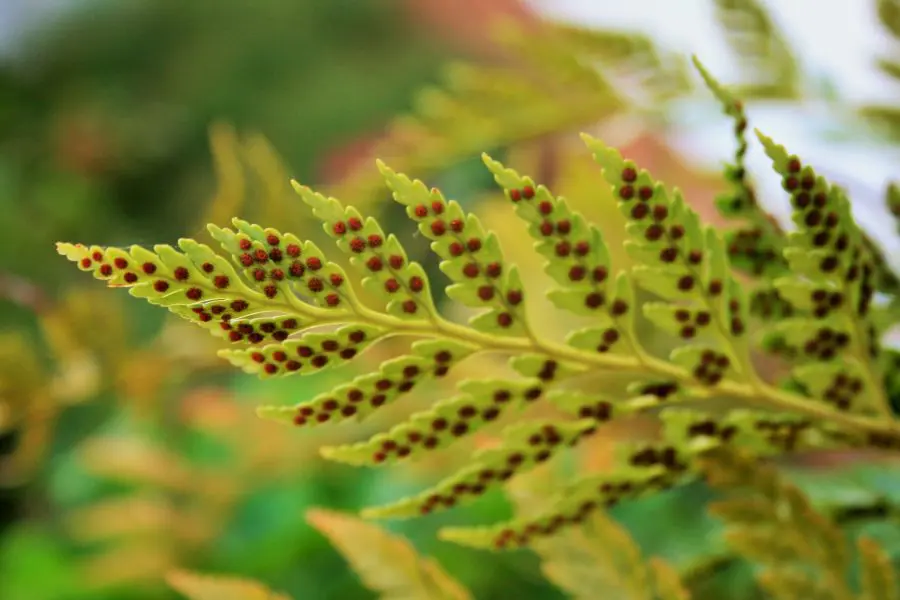
Division – One of the easiest ways to propagate Bird’s Nest Ferns is by dividing the parent plant.
Simply remove the plant from its pot, gently tease apart the roots and separate the individual plants, making sure each one has a healthy root system.
Spores – Another method of propagation is by using spores. Spores are tiny dust-like particles that are produced by the fern’s fronds.
To propagate using spores, you’ll need to collect the spores and plant them in a special medium.
Rhizome cuttings – You can also propagate Bird’s Nest Ferns by taking rhizome cuttings.
Rhizomes are underground stems that produce new shoots and roots. To propagate using rhizome cuttings, cut off a section of the rhizome with a sharp, clean knife and plant it in a new pot with fresh soil.
Tips for Successful Bird’s Nest Fern Propagation:
Use sterile tools Whether you’re dividing the plant or taking rhizome cuttings, it’s important to use sterile tools to avoid introducing any pathogens to the new plant.
Keep the environment humid Bird’s Nest Ferns prefer a humid environment, so it’s important to keep the soil and air around the plant moist during the propagation process.
Provide indirect light While the parent plant might tolerate direct sunlight, newly propagated plants need to be protected from direct light until they have had a chance to establish themselves.
Be patient Propagating Bird’s Nest Ferns takes time, so be patient and give your new plants time to establish themselves before moving them to their permanent homes.
Bird’s Nest Fern Feng Shui
If you’re looking for an indoor plant that not only adds beauty to your space but also brings positive energy, then Bird’s Nest Fern might be the perfect choice for you!
This fern is not just an attractive addition to your home but also a powerful Feng Shui tool that can enhance the energy flow of your living space.
In this section, we will discuss how to use Bird’s Nest Fern in Feng Shui and bring harmony and balance to your home.
Bird’s Nest Fern placement for good Feng Shui:
The placement of Bird’s Nest Fern is crucial for good Feng Shui.
According to Feng Shui principles, the east and southeast areas of your home are associated with growth and abundance, making them the perfect spots for this plant.
You can also place it in the west or northwest areas of your home to enhance creativity and communication.
Benefits of having a Bird’s Nest Fern in your home:
Besides its aesthetic appeal, Bird’s Nest Fern offers several benefits to your home’s energy flow.
It helps to purify the air by removing toxins, and its lush green color represents growth and vitality.
Additionally, the round shape of the plant’s leaves is believed to attract positive energy and promote feelings of calmness and tranquility.
Overall, having a Bird’s Nest Fern in your home can help to create a peaceful and harmonious environment.
Bird’s Nest Fern in the Bathroom
The bathroom may not be the first place that comes to mind when you think of indoor plants, but the Bird’s Nest Fern can thrive in the warm, humid environment of your bathroom.
In fact, this fern is well-suited to growing in this space and can add a touch of natural beauty to your bathroom decor.
In this section, we’ll explore the benefits of having a Bird’s Nest Fern in your bathroom and offer tips for caring for this plant in this unique setting.
Benefits of having a Bird’s Nest Fern in the bathroom:
Adding a Bird’s Nest Fern to your bathroom decor can be both visually pleasing and beneficial.
Bird’s Nest Ferns thrive in warm and humid environments, which makes the bathroom a perfect spot for them.
These plants can help purify the air, improve humidity levels, and add a touch of greenery to your space.
Tips for caring for a Bird’s Nest Fern in the bathroom:
To keep your Bird’s Nest Fern healthy in the bathroom, ensure it receives enough bright, indirect light.
Water it regularly to maintain the soil moist, but not waterlogged. As humidity is key for these plants, it is essential to mist them frequently, especially during dry seasons.
You can also place a tray of pebbles filled with water near the fern to create a more humid environment.
Remember to avoid placing your Bird’s Nest Fern near cold drafts or heat vents as they don’t like sudden temperature changes.
Bird’s Nest Fern Outdoors
If you’re lucky enough to live in a warm, humid climate, you might want to consider growing your Bird’s Nest Fern outdoors.
In this section, we’ll explore the benefits of having an outdoor Bird’s Nest Fern, as well as the care requirements you need to keep in mind to help your fern thrive.
So, let’s dive in and learn how to care for your Bird’s Nest Fern in the great outdoors!
Benefits of having a Bird’s Nest Fern outdoors:
While Bird’s Nest Ferns are typically grown indoors, they can thrive outside too.
One of the benefits of having a Bird’s Nest Fern outdoors is that it can grow much larger in size compared to indoor plants.
Outdoor plants can also better benefit from natural light, rainwater, and fresh air. Plus, they can add a lush, tropical look to your garden or patio.
Tips for caring for a Bird’s Nest Fern outdoors:
When growing Bird’s Nest Ferns outdoors, it’s important to choose a spot with the right amount of light and moisture.
They prefer bright, indirect light and soil that’s kept consistently moist but not waterlogged.
You may also need to fertilize them occasionally to help them grow to their fullest potential.
USDA zones and hardiness and lowest temperature
Bird’s Nest Ferns are typically hardy to USDA zones 9-11, meaning they can tolerate temperatures as low as 25-30°F (-3.9 to -1.1°C).
However, it’s best to keep them out of direct sunlight and protect them from frost or extreme temperatures.
If you live in a cooler climate, you may need to bring your outdoor Bird’s Nest Fern inside during the colder months to ensure its survival.
Bird’s Nest Fern FAQs
Bird’s Nest Ferns are unique and versatile plants that make excellent houseplants. They have specific but straightforward care requirements.
Whether you’re new to houseplants or just adding to your indoor jungle, it’s important to know how to properly care for a Bird’s Nest Fern to ensure its longevity and lush growth.
Here are some commonly asked questions and answers to guide you through your journey with this wonderful plant.
Q: How much sun does a bird’s nest fern need?
A: Bird’s Nest Ferns prefer indirect sunlight. Too much direct sun can scorch the leaves, while too little light may cause slow growth.
Q: Do birds nest ferns like to be misted?
A: Yes, Bird’s Nest Ferns enjoy high humidity and will appreciate being misted regularly, especially in dry indoor environments.
Q: Why are the tips of my bird’s nest fern turning brown?
A: Brown tips could be a result of inconsistent watering, low humidity, or fertilizer burn.
Make sure you are watering the plant regularly and maintaining high humidity levels.
Q: Where should I put my bird’s nest fern?
A: The plant does well in a spot with indirect sunlight and high humidity.
Bathrooms or kitchens often make ideal locations due to their higher moisture levels.
Asplenium nidus Conclusion
And there you have it, a comprehensive guide on caring for your Bird’s Nest Fern!
Whether you’re a seasoned plant parent or a beginner, this guide has provided you with all the necessary information to successfully care for your plant.
Remember to always give your Bird’s Nest Fern the love and attention it needs, and don’t forget to enjoy its beauty and benefits. Happy planting!
Summary of key takeaways:
In summary, Bird’s Nest Ferns are beautiful indoor plants that require specific care to thrive.
It’s important to understand their light, temperature, soil, watering, and repotting needs, as well as how to propagate them and troubleshoot common problems.
Proper care can lead to benefits such as improved air quality, reduced stress levels, and even good feng shui.
Final thoughts on caring for Bird’s Nest Ferns indoors:
Caring for Bird’s Nest Ferns can be a rewarding experience for any plant lover.
With a little bit of knowledge and effort, you can create a beautiful and healthy indoor environment for your fern.
Remember to keep it away from direct sunlight, maintain appropriate humidity levels, and use well-draining soil.
With regular watering, proper fertilization, and occasional repotting, your Bird’s Nest Fern can flourish and bring natural beauty into your home for years to come.
You can buy your own Bird’s Nest Fern here on Amazon
Read More: Indoor Ferns Care: 11 Tips And Tricks For Beginners












